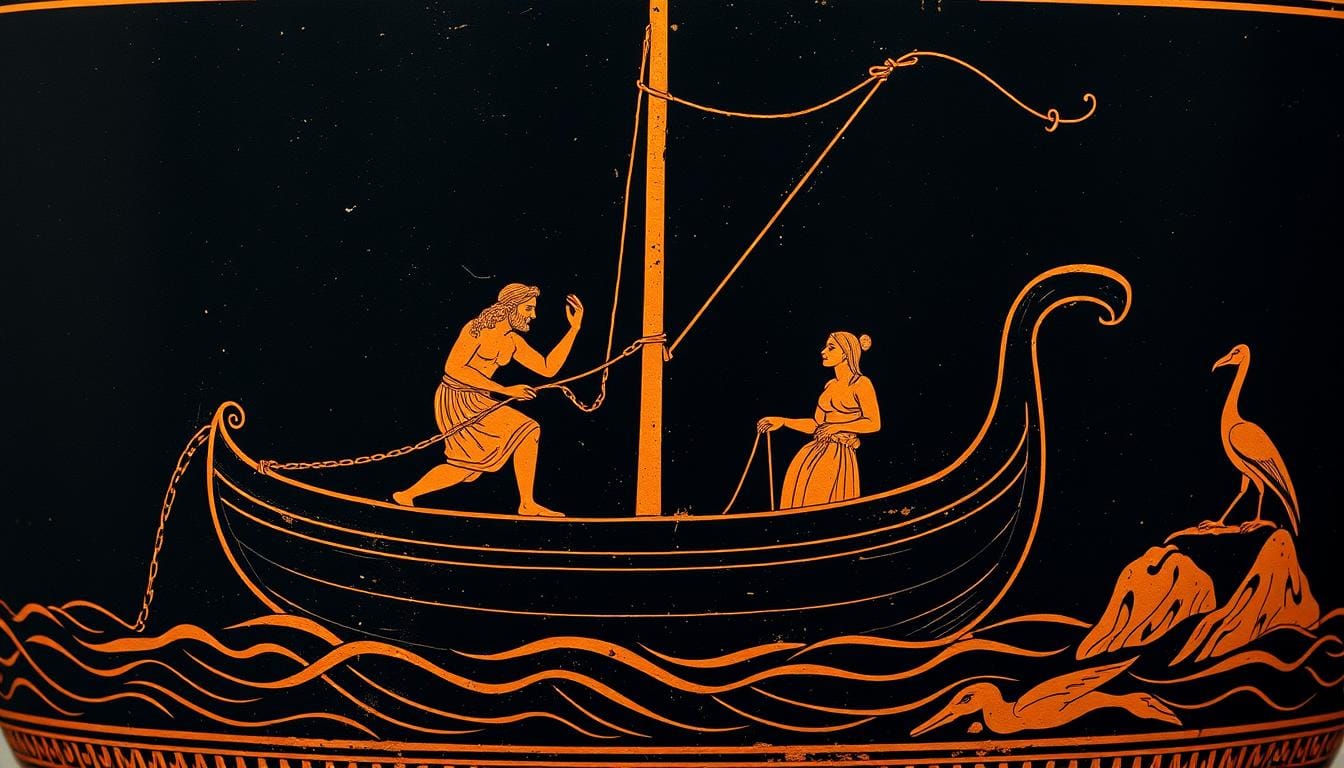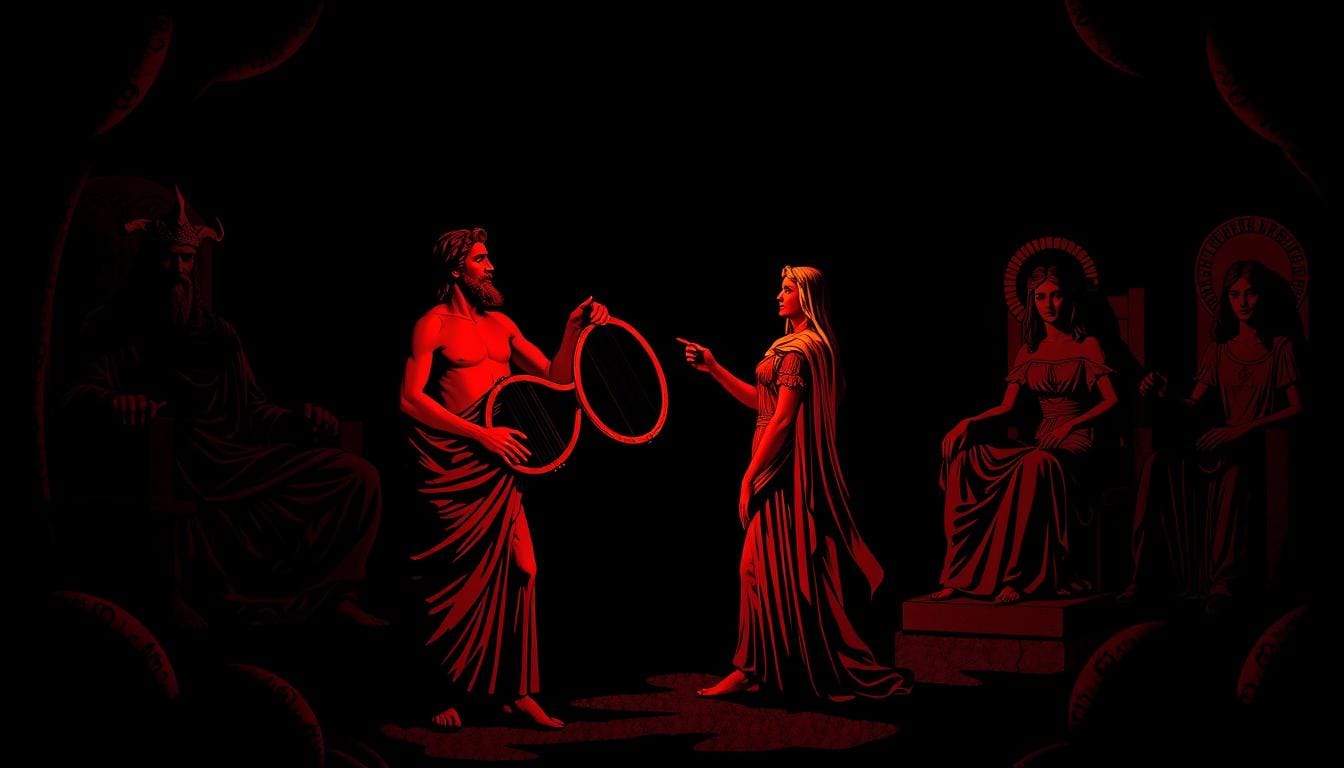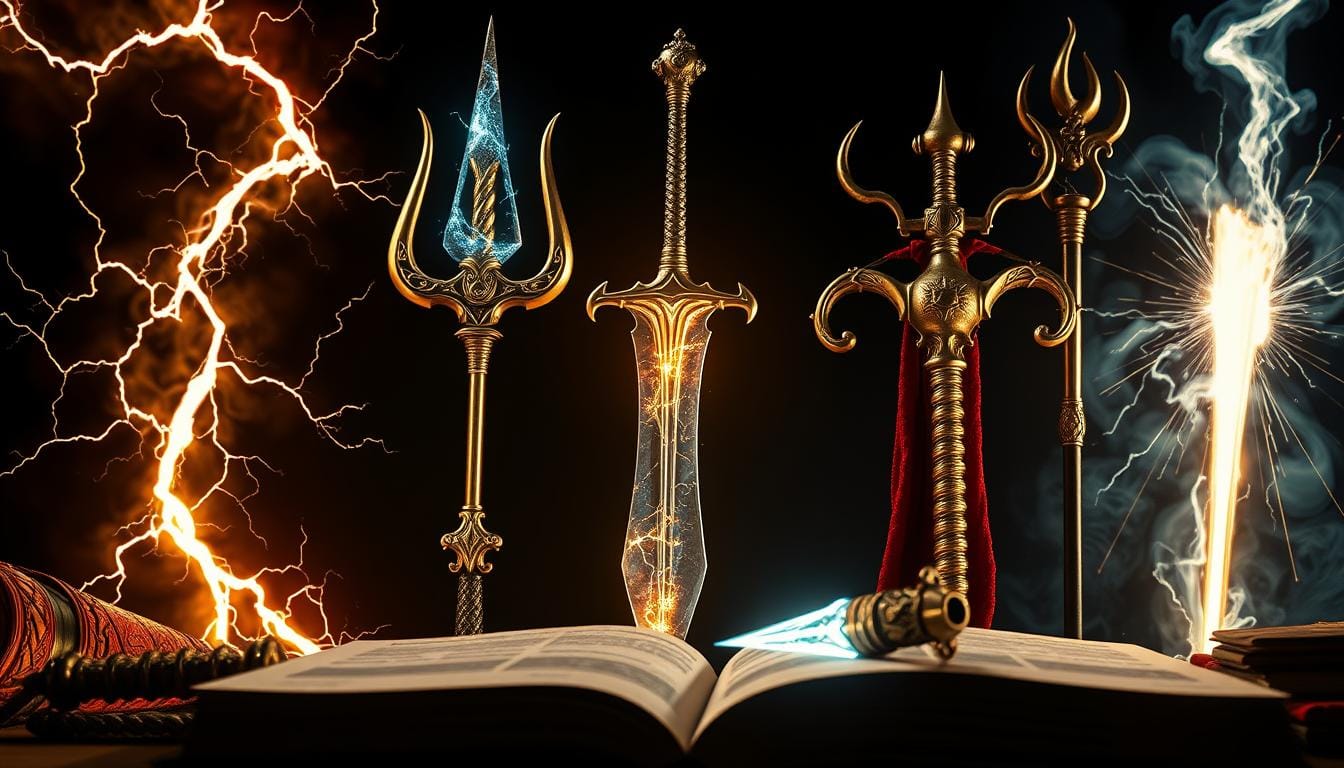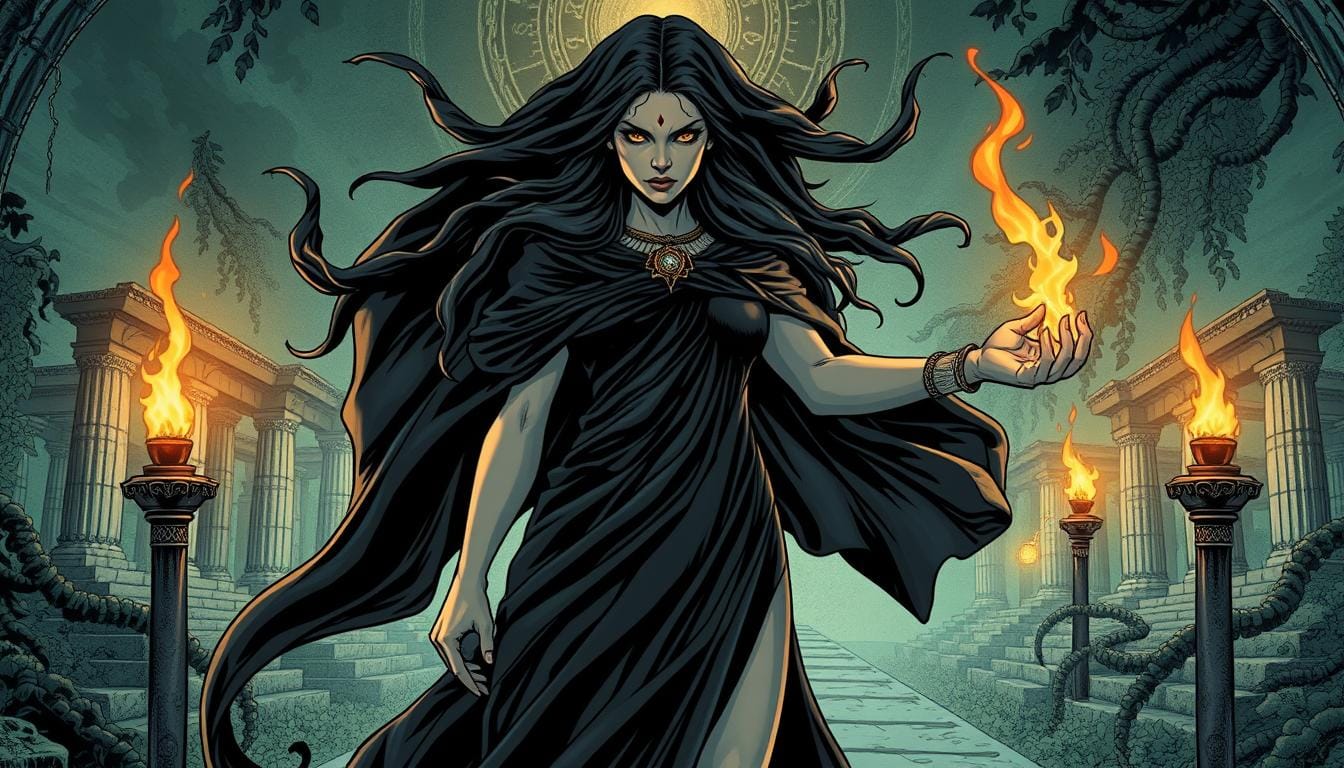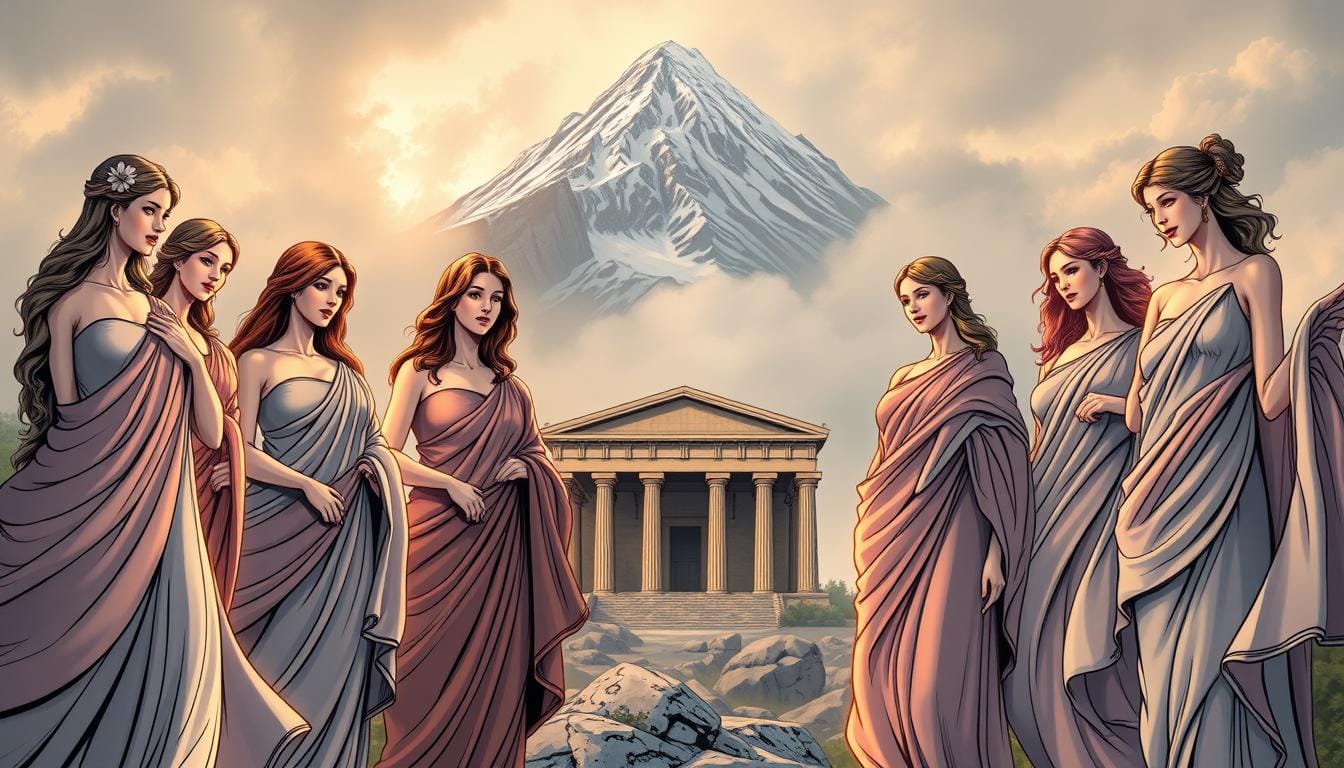While most Olympian deities were known for their beauty, Hephaestus was different. He had physical flaws but created the most magnificent artifacts in Greek mythology. This paradox makes him unique. Despite being cast from Mount Olympus as an infant, he became the most essential craftsman among the gods.
The bearded deity wielded his tools with unmatched skill. He transformed raw metal into wonders that even Zeus coveted. His forge burned with eternal flames, producing everything from golden automatons to impenetrable shields. Unlike other Olympian deity figures who ruled through beauty or strength, this divine artisan earned respect through pure talent and dedication.
His Roman counterpart Vulcan shared the same mastery over fire and metalworking. From his volcanic workshops, he created artifacts that shaped the course of mythological history and influenced countless tales of heroism.
Key Takeaways
- Hephaestus was the Olympian god of fire, smiths, metalworking, and craftsmanship
- Despite physical imperfections, he became one of the most essential deities on Mount Olympus
- He created legendary weapons and artifacts coveted by gods and heroes alike
- His Roman counterpart was Vulcan, sharing the same divine domains
- He transformed from an outcast infant into the master artisan of the gods
- His eternal forge produced everything from golden automatons to impenetrable shields
Origins and Mythological Background
The birth story of Hephaestus is both tragic and compelling. Unlike many Olympic gods, he was born in rejection and family conflict. Ancient Greek sources tell different versions of his origins, creating a rich tapestry of Hephaestus myths that have fascinated scholars for centuries.
These different tales show the complex nature of Greek mythology. Various regions and time periods had their own versions of the same stories. This makes Hephaestus a multifaceted character, telling us about ancient Greek society and the god himself.
Birth of Hephaestus
The birth of Hephaestus is a topic of debate in Greek mythology. Homer’s Iliad says he is Zeus and Hera’s son, born into the royal family of Olympus. But Hesiod’s account tells a different story.
Hesiod says Hera had Hephaestus without Zeus’s help. She created him through parthenogenesis, out of jealousy over Zeus’s creation of Athena. This shows the competitive nature of divine relationships and Hera’s desire to prove her creative powers.
The most heartbreaking part of these Hephaestus myths is his birth condition. Born with a noticeable limp or deformity, he was immediately rejected. Hera, disgusted by his appearance, cast him from Mount Olympus in a cruel act.
Family Relations of Hephaestus
Hephaestus’s family dynamics show the complex relationships in the Olympic pantheon. His relationship with his parents, Hera, was strained. The trauma of his early rejection shaped his interactions with other divine family members.
Zeus’s role in Hephaestus’s story varies by source. In some accounts, Zeus also rejected his son, throwing him from Olympus during a family quarrel. This double rejection adds tragedy to the divine artisan’s character.
Despite these difficult beginnings, Hephaestus found acceptance among some family members. His relationships with Athena and Aphrodite were central to many myths.
Key Myths Involving Hephaestus
The most transformative period in Hephaestus’s life was after his fall from Olympus. He was rescued by the sea nymphs Thetis and Eurynome. They became his surrogate mothers, providing the love his biological parents denied.
For nine years, Hephaestus lived with them, hidden from the other gods. During this time, he discovered his talent for craftsmanship. The divine artisan created beautiful jewelry and ornaments for his adoptive mothers, perfecting the skills that made him indispensable to the Olympic pantheon.
This period of exile and learning shaped his character. The rejection he experienced taught him empathy. His isolation allowed him to perfect his craft without interference. These early experiences made him a god who valued skill over appearance and loyalty over power.
Attributes and Symbolism
Hephaestus is more than just a blacksmith deity. He represents creation itself. His divine nature blends physical skill with spiritual growth. The god’s many names and sacred items show deep meanings to ancient Greeks.
Every symbol of this powerful god tells a story of human dreams and divine help. The Hephaestus attributes we look at today inspire us today to be creative and never give up.
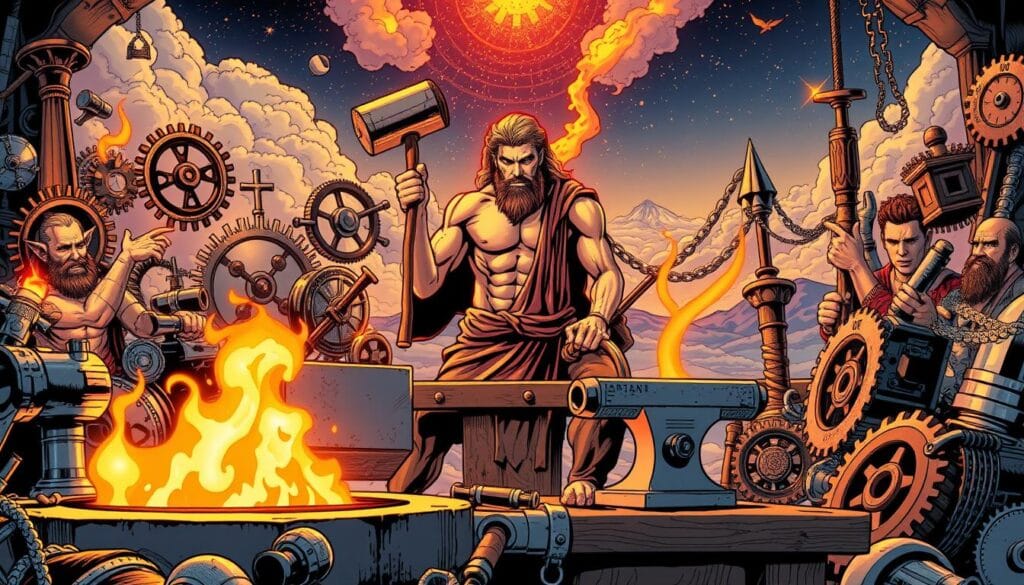
Fire as a Element of Creation
Fire is at the heart of Hephaestus’s power and creativity. His fire turns raw materials into art and useful things. This element is both a tool and a symbol of divine inspiration.
Ancient Greeks saw volcanic fires as Hephaestus’s earthly workshops. Places like Mount Etna and Lemnos were sacred. People believed the god worked there, linking natural fire with divine creativity.
Fire’s power to change things mirrors Hephaestus’s own journey. Like fire purifies metals, his experiences made him stronger. This shows he supports those who keep creating despite challenges.
Craftsmanship and Innovation
The Hephaestus attributes of skill and innovation set him apart. His work shows human desire to improve and create. Ancient craftsmen looked to him for inspiration and protection.
He was known as Klytotékhnēs, or “renowned artificer.” His skills in metalwork and jewelry making were unmatched. This made him a patron of all who worked with their hands.
Innovation is a part of his divine nature. He didn’t just copy designs; he created new ones. His golden servants and automated tripods show how creativity can go beyond limits.
His divine craftsmanship made human work sacred. Artisans saw their skills as gifts from Hephaestus. This connection encouraged excellence in all making.
Tools and Symbols Associated with Hephaestus
The main Hephaestus symbols are the smith’s hammer, anvil, and tongs. These tools symbolize transformation and creation. Each tool has deeper meanings beyond its use.
The hammer stands for the power to shape destiny through hard work. The anvil represents stability and endurance in creating. It shows that great works need patience and support.
The tongs symbolize precision and control over dangerous forces. Fire and molten metal need careful handling, just like creative power. These tools show the balance between force and finesse.
His names reveal more about his character and abilities. Amphigyḗeis, or “the lame one,” shows his physical difference but also his greatness. Khalkeús connects him to specific metalworking traditions.
The title Aithalóeis theós, or “sooty god,” celebrates the honest dirt of hard work. Unlike other gods, Hephaestus showed the marks of his labor. This made him relatable to working people.
These symbols and attributes paint a complete picture of divine craftsmanship. The blacksmith deity is not just a maker but a symbol of human dreams realized through dedication and skill.
Hephaestus in Greek Literature
Greek writers turned Hephaestus into a complex character. His stories touched on human struggles and victories. They showed his role in exploring themes like disability, creativity, and the mix of divine and human skills. This made Hephaestus a relatable figure in Greek mythology.
Depictions in Homer's Works
Homer’s poems are filled with memorable scenes of Hephaestus. In the Iliad, he battles Scamander with fire, showing his power and loyalty. This scene is a highlight of ancient literature.
In the Iliad, Hephaestus also makes Achilles’ armor. This shows his incredible skill as a divine craftsman. It also highlights his compassion for Thetis.
The Odyssey tells the story of Hephaestus trapping Aphrodite and Ares. This shows his cleverness and vulnerability. The gods’ laughter adds humor, touching on themes of betrayal and justice.
Plays Featuring Hephaestus
Greek playwrights built on Homer’s work, exploring deeper themes. Aeschylus’ “Prometheus Bound” shows Hephaestus’ inner conflict. He reluctantly chains Prometheus, showing his struggle between duty and compassion.
Later plays contrast Hephaestus’ physical limitations with his creative genius. This made him a symbol of overcoming adversity.
Influence on Later Literary Traditions
The Homeric Hymns celebrate Hephaestus as a teacher of humanity. He works with Athena to improve civilization through craftsmanship. This view of him as a civilizing force inspired many writers.
Roman authors, like Virgil and Ovid, used Hephaestus in their works. Medieval and Renaissance writers also drew from these stories. Hephaestus became a symbol of artistic achievement and human resilience in Western literature.
The Role of Hephaestus in Greek Mythology
Hephaestus, the forge god, played a complex role in Greek mythology. He was both an outsider and a key craftsman to the gods. His unmatched skill in creating divine weapons and magical items defined Olympus’s power structure.
Despite his physical appearance, Hephaestus became essential. His talents made him indispensable to the gods.
Position Among the Twelve Olympians
Hephaestus became an Olympian deity through his skills, not birth. He used creation and innovation to influence others. His workshop on Mount Olympus was the most advanced, with twenty magical bellows.
As the gods’ blacksmith, he made everything from Zeus’s thunderbolts to Hermes’ sandals. His creations were not just useful but also beautiful, boosting the gods’ powers. The Aegis breastplate and Achilles’ armor were his masterpieces.
His workshop was a hub for gods to get special items. This gave him insight into divine politics and secrets.
Complex Divine Relationships
Hephaestus had complex relationships with the gods. His marriage to Aphrodite was tumultuous due to her affair with Ares. This led to a famous golden net trap episode.
His partnership with Athena was more harmonious. They shared skills in crafts and innovation. Together, they taught mortals metalworking and pottery, creating Pandora.
His relationship with his parents was complicated. Hera’s initial rejection of him due to his lameness caused tension. But Zeus welcomed him back, recognizing his value.
Pivotal Mythological Events
Several key events in Greek mythology involved Hephaestus. The creation of Pandora was part of Zeus’s plan to punish humanity. His armor for Achilles influenced the Trojan War.
Trapping Aphrodite and Ares showed his cunning. It showed he could outsmart even the god of war.
Freeing Hera from his golden throne showed his power and forgiveness. This act earned him permanent acceptance among the Olympians.
Through these stories, Hephaestus showed that true value comes from skill and dedication, not physical perfection.
Famous Artworks Featuring Hephaestus
Artists across the world have been inspired by Hephaestus. They’ve created many works that celebrate his divine craftsmanship. From small figurines to large temple sculptures, these pieces show how different cultures saw this complex god.
The journey of Hephaestus in art starts with small statues. Ancient Greeks placed these statues near their hearths. They connected him to daily life, showing his importance.
Statues and Sculptures
Creating Hephaestus statues was a challenge. Artists had to show his divine side and his disability. The famous statue by Alcamenes in Athens solved this problem well. It showed the god’s lameness subtly.
Most sculptures depict Hephaestus as a middle-aged, bearded craftsman. He’s shown with strong arms and shoulders from his work. His tools are often nearby, making it easy to identify him.
Some sculptures show a younger, beardless Hephaestus. These works highlight his creative power over his physical challenges. This shows how ancient artists were flexible in their interpretations.
Paintings and Mosaics
Vase paintings and mosaics gave artists more freedom. They told stories from Greek mythology. Scenes like his return to Olympus and creating Pandora were popular.
One famous scene shows Hephaestus trapping Aphrodite and Ares. Artists used this story to explore themes of betrayal and justice. The paintings often included detailed workshop settings.
Roman mosaics added their own cultural elements. They often showed Hephaestus in his forge, surrounded by craftsmen. These works highlighted the dignity of skilled labor, a Roman value.
Modern Interpretations in Art
Today, artists are reimagining Hephaestus for modern audiences. They focus on themes like disability representation and the value of craftsmanship. These works challenge old views while honoring ancient traditions.
Modern sculptures often show Hephaestus as a symbol of perseverance. They show how physical challenges can go hand in hand with talent. This resonates with today’s discussions about ability and achievement.
Digital artists have created new interpretations using technology. These works explore the mix of traditional craftsmanship and modern innovation. They blend classical Hephaestus symbols with modern industrial imagery.
| Artistic Period | Common Depictions | Key Characteristics | Notable Examples |
|---|---|---|---|
| Ancient Greek | Bearded craftsman with tools | Subtle disability portrayal | Alcamenes statue in Athens |
| Roman | Workshop scenes with assistants | Emphasis on labor dignity | Pompeii villa mosaics |
| Renaissance | Mythological narrative scenes | Classical revival themes | Velázquez forge paintings |
| Modern | Disability representation focus | Technology and craft fusion | Contemporary sculpture installations |
The evolution of Hephaestus in art shows how culture and techniques have changed. Each era has brought new interpretations. From ancient guardians to modern gallery pieces, the divine artisan continues to inspire.
Hephaestus' Influence on Modern Culture
Modern culture has taken the fire god’s legacy and turned it into exciting stories today. The Hephaestus myths inspire many, showing how skill can overcome physical challenges. His Roman version, Vulcan, also shapes our entertainment.
Hephaestus’ story touches many today. It’s about feeling like an outsider but finding worth in one’s craft. This message is powerful and relatable.
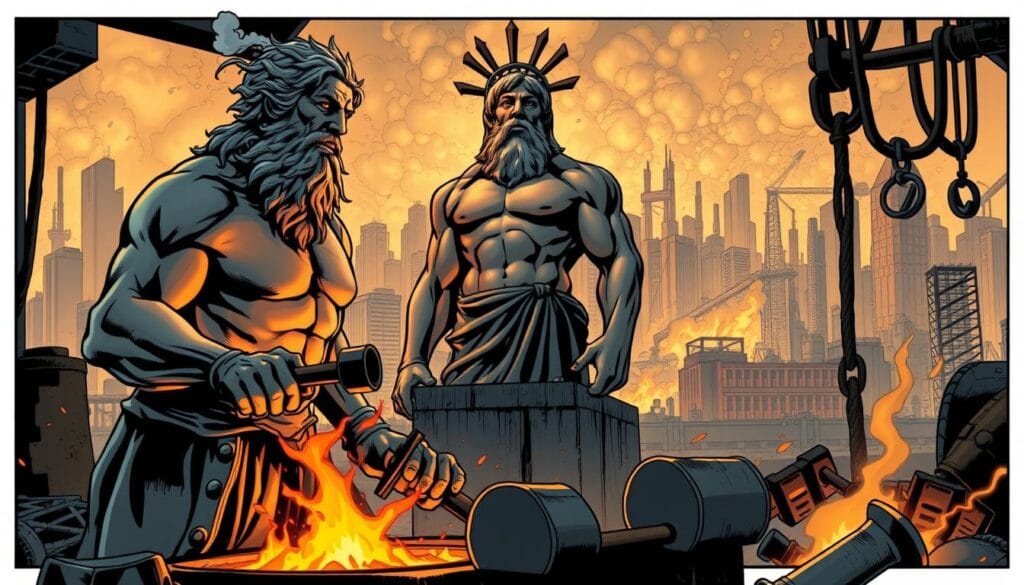
Representation in Movies and TV
Hollywood has seen the drama in Hephaestus myths in recent years. He appears in fantasy films and TV shows. For example, “Clash of the Titans” and “Immortals” show him making legendary items.
TV shows love Hephaestus too. “Percy Jackson” and “American Gods” give him a modern twist. They highlight his role as a master inventor.
Vulcan also makes an impact in science fiction, like in Star Trek. The Vulcan race shares Vulcan’s values of skill, logic, and technology. This shows how ancient themes can fit into the future.
Hephaestus in Literature Today
Authors today find Hephaestus myths rich for exploring themes. Rick Riordan’s “Percy Jackson” series shows him as a caring father who values ingenuity. Young adult books often use him to talk about disability and self-acceptance.
“The god of the forge teaches us that true power comes not from perfection, but from the ability to create something beautiful from raw materials and determination.”
Fantasy books see the blacksmith deity as a symbol of the maker movement. Authors like Neil Gaiman and Rick Riordan show him supporting inventors and craftspeople. This shows his relevance in our tech world.
Science fiction writers compare ancient Vulcan to modern engineering. Vulcan’s skills with fire and metal fit well into stories about AI and advanced manufacturing.
Popular Culture References
Video games often use Hephaestus myths in their stories. Games like “God of War” and “Assassin’s Creed Odyssey” feature him as a quest-giver. Players seek him out for legendary weapons.
The maker movement sees Hephaestus as a patron. Blacksmiths and engineers reference him when talking about the value of manual labor. Maker spaces often display images or quotes about the fire god.
| Media Type | Popular Examples | Character Portrayal | Key Themes |
|---|---|---|---|
| Movies | Clash of the Titans, Immortals | Divine weaponsmith | Creation through fire |
| Television | Percy Jackson, American Gods | Modern inventor | Technology and craft |
| Literature | Percy Jackson series, Neil Gaiman works | Caring mentor figure | Disability acceptance |
| Video Games | God of War, Assassin’s Creed | Master craftsman | Skill over strength |
Social media loves Hephaestus and Vulcan for talking about craftsmanship and innovation. Hashtags like #HephaestusSpirit pop up in posts about metalworking and engineering.
The blacksmith deity remains a big part of our culture. His story inspires us to keep creating and innovating. It teaches us about perseverance, skill, and finding purpose through meaningful work.
Hephaestus and the Concept of Craftsmanship
Hephaestus is more than a metalworker. He is the divine artisan who turns raw materials into masterpieces. Alongside Athena, he taught humans to create beauty from chaos. His work showed that craftsmanship was key in ancient Greek society.
Ancient Greeks believed that civilization needed skilled hands and creative minds. They saw Hephaestus as the source of all technical knowledge. His guidance helped people shape metal, build structures, and create tools.
The Importance of Craft in Ancient Greece
In ancient Greece, craftsmanship was highly valued. The concept of techne – art and skill – was seen as a divine gift. Craftsmen were artists with sacred knowledge from Hephaestus.
Greek society saw skilled artisans as the foundation of civilization. Blacksmiths made weapons, potters created vessels, and builders built temples. These creations honored the gods.
The forge god showed the dignity of manual labor. Hephaestus taught that true worth came from creation, not physical beauty. His workshops produced marvels that even gods couldn’t match.
Artisans in Greece looked to Hephaestus as their patron. They saw their skills as a connection to divine power. Every creation was an act of worship to the god who taught them.
Lessons from Hephaestus on Skill and Creation
Hephaestus’ myths teach about persistence, innovation, and skill’s power. Despite challenges, he became the most skilled creator on Mount Olympus. His story shows that limitations can be strengths with dedication.
Hephaestus showed that mastery needs patience and passion. His works were planned and executed with precision. The Hephaestus attributes of determination and detail became models for craftsmen.
His relationship with fire shows the power of controlled creation. Fire can destroy or transform, depending on the skill of the user. Hephaestus taught that knowledge and respect for materials are key.
Hephaestus’ willingness to help both gods and mortals shows the value of craftsmanship. His creations solved problems, protected people, and brought beauty. This service-oriented approach was central to Greek artisan culture.
Modern Craftsmanship Inspired by Hephaestus
Today’s makers and creators draw inspiration from Hephaestus. Modern blacksmiths, metalworkers, and artisans carry on his legacy. They see their work as connecting them to an ancient tradition.
Contemporary engineers and designers follow Hephaestus’ model of innovation. They transform raw materials into solutions that improve life. Their work echoes the spirit of creative determination that drove Hephaestus.
The maker movement of the 21st century reflects Hephaestus’ values. People are rediscovering the joy of creating with their hands. They find meaning in learning skills, solving problems, and producing tangible results.
Modern craftspeople also embrace Hephaestus’ inclusive message. Anyone can develop skills, regardless of background or physical limitations. His example encourages finding one’s path to mastery and valuing the journey.
The divine artisan continues to inspire those who believe in human creativity and skill. From traditional crafts to cutting-edge technology, his influence reminds us of our power to create and transform.
Worship and Temples Dedicated to Hephaestus
In Greece, temples dedicated to Hephaestus were built. These places were where craftsmen and regular people honored the fire god. Hephaestus was special because he was a god and a helper to working people. His worship was simple, focusing on everyday work and skills.
The worship of Hephaestus was different from other gods in Greek mythology. His temples were where artisans and metalworkers met. These places were not just for worship but also for networking and learning.

Major Temples around Greece
Lemnos was the main place for Hephaestus worship. It was said that Hephaestus first landed there after being thrown off Mount Olympus by Zeus. The people of Lemnos saw themselves as chosen by Hephaestus and kept his worship alive for a long time.
The priests of Lemnos used special earth from the island for healing. They believed this earth could cure snake bites and other illnesses. People from all over came to get this earth and seek the god’s blessing.
Athens had a magnificent temple for Hephaestus, the Hephaesteum. It stood over the ancient Agora, where merchants and craftsmen worked every day. The temple’s location showed Hephaestus’s link to work and trade.
The Hephaesteum was full of Hephaestus symbols. Its walls showed scenes of making things and divine creation. It was a place of worship and a showcase of Athenian art.
Festivals Celebrating Hephaestus
The Hephaestia festival was the biggest celebration for Hephaestus. It happened every year on Lemnos and drew craftsmen from all over Greece. They showed off their skills and made new things.
Athens had the Chalkeia festival, honoring Hephaestus and Athena together. This festival showed their shared love for crafts and technology. It took place in late autumn, starting the winter crafting season.
During these festivals, craftsmen showed their skills. They taught apprentices and shared new ideas. These events helped people work together and learn from each other.
| Festival Name | Location | Duration | Main Activities |
|---|---|---|---|
| Hephaestia | Lemnos | 3 days | Craft competitions, healing rituals |
| Chalkeia | Athens | 2 days | Joint worship with Athena, tool blessing |
| Vulcanalia | Various cities | 1 day | Fire ceremonies, metalwork displays |
| Forge Festivals | Industrial centers | Seasonal | Workshop demonstrations, apprentice initiations |
Rituals and Offerings
Worshippers gave special gifts to Hephaestus. They offered handmade tools, metalwork, and the first things they made. These gifts showed respect for the god’s skills and asked for his help in their work.
Blacksmiths gave their best hammers and tongs. Jewelers offered beautiful ornaments. Even simple workers gave tools they made themselves. The value was in the skill and effort, not the materials.
Ritual fires were key in Hephaestus worship. Fires burned in his temples, tended by priests. These fires symbolized creativity and the power of heat in making things.
Healing rituals used fire and earth. Priests heated special Lemnian soil and used it to heal wounds. This showed Hephaestus’s connection to fire and earth.
Hephaestus worship was special because it celebrated human skill and divine inspiration together. His temples were places of learning where Greek mythology and practical skills were passed down to future generations.
Conclusion: The Legacy of Hephaestus
Hephaestus’s story is a powerful tale of change and victory in Greek mythology. This blacksmith god went from being rejected as a baby to becoming a key figure in the gods’ world. He made famous weapons and armor for gods and heroes.
The Lasting Impact on Art and Culture
Hephaestus inspires artists, writers, and creators worldwide. His work is seen in many sculptures, paintings, and modern works that honor the divine in craftsmanship. Vulcan, his Roman counterpart, also keeps his artistic legacy alive, showing the lasting charm of the God of Fire and Craftsmanship.
Hephaestus as a Symbol of Perseverance
His story teaches us about facing and beating challenges. Dionysus brought him back to Olympus, making him one of the few gods to return after being banished. This story inspires those who have faced rejection or physical hurdles.
Final Thoughts on the God of Fire and Craftsmanship
Hephaestus made winged helmets for Hermes and powerful armor for Achilles. He showed that skill and hard work are more important than looks. His legacy teaches us that our true value comes from what we create and contribute. Today, his story inspires innovators and inventors to strive for greatness through fire, forge, and determination.
